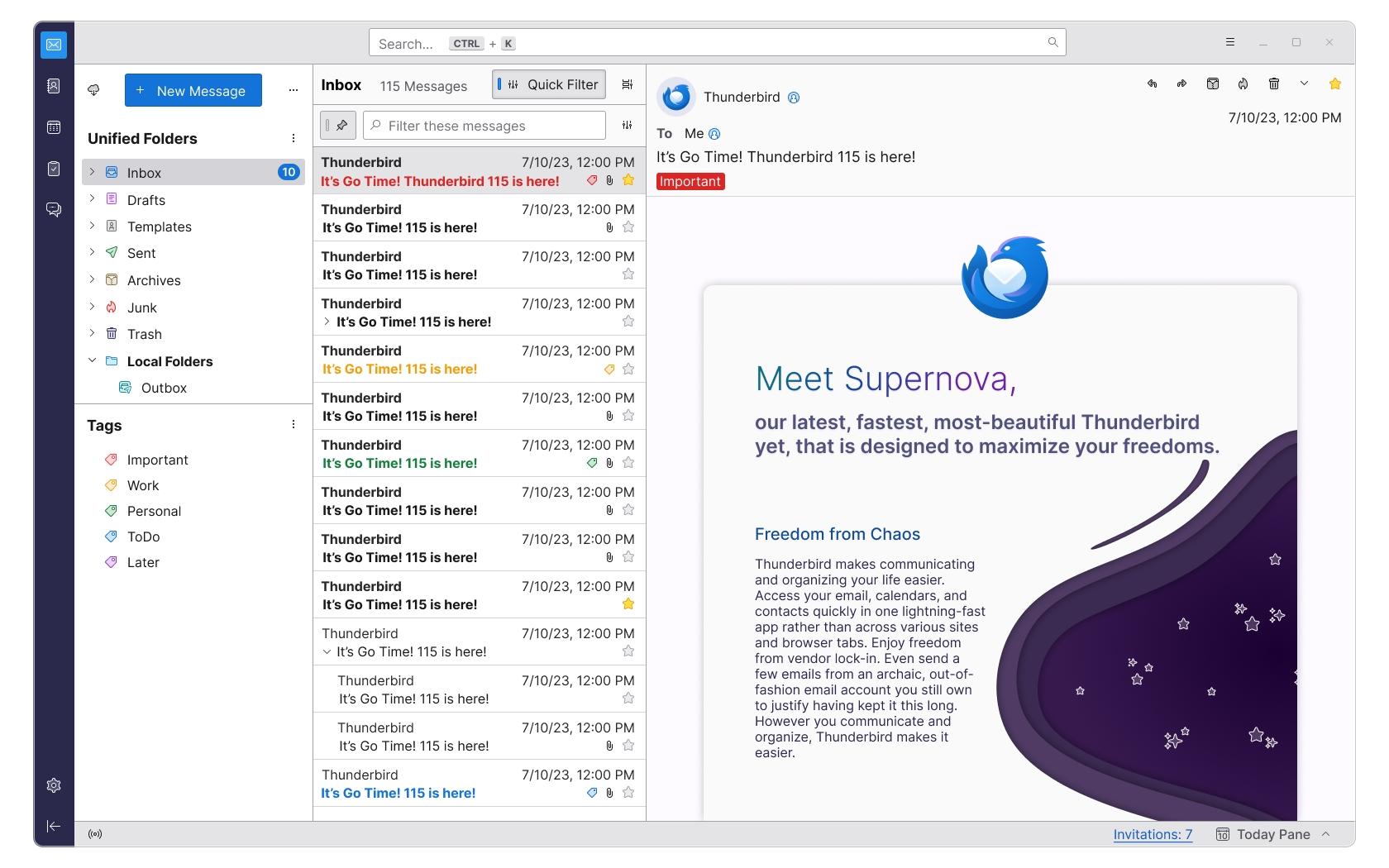
Mozilla Thunderbird is a reliable and versatile email client that provides users with an efficient way to manage their email correspondence. With a multitude of features and customizable options, Thunderbird simplifies the process of organizing, sending, and receiving emails. Whether you are new to Thunderbird or looking to enhance your email management skills, this article will guide you through the various functionalities and settings of this popular email client. So, let’s dive in and discover how to make the most out of Mozilla Thunderbird!
Setting Up Your Mozilla Thunderbird Account
Mozilla Thunderbird is a free and open-source email client that allows you to manage multiple email accounts effortlessly. Setting up your Thunderbird account is a quick and simple process, so let’s get started! Follow these steps to configure your Thunderbird account and start enjoying a more organized email experience.
<p>
<strong>Step 1: Download and Install Thunderbird</strong>
<br>
The first step to setting up your Thunderbird account is to download and install the application on your computer. Visit the official Mozilla Thunderbird website and download the appropriate version for your operating system. Once the download is complete, run the installation file and follow the on-screen instructions to install Thunderbird.
</p>
<p>
<strong>Step 2: Launch Thunderbird and Click on "Create New Account"</strong>
<br>
After you have successfully installed Thunderbird, launch the application on your computer. On the main interface, click on the "Email" option located under "Create a new account." This will initiate the account setup wizard that will guide you through the process of setting up your email account.
</p>
<p>
<strong>Step 3: Enter Your Name and Email Address</strong>
<br>
In the account setup wizard, you will be prompted to enter your name and email address. Fill in your full name as you want it to appear in outgoing emails and provide the email address associated with the account you wish to set up. Click on the "Next" button to proceed.
</p>
<p>
<strong>Step 4: Choose Your Account Type</strong>
<br>
Thunderbird supports various email account protocols, including POP3, IMAP, and Exchange. Select the account type that matches the server settings for your email provider. If you are unsure, check with your email provider for the correct account type. After selecting the account type, click on the "Next" button.
</p>
<p>
<strong>Step 5: Enter Account Settings and Finish Setup</strong>
<br>
Finally, you will need to provide the incoming and outgoing mail server settings for your email account. These settings can usually be obtained from your email provider's website or by contacting their support team. Once you have entered the server settings, click on the "Next" button to finish the setup process. Thunderbird will then attempt to connect to your email server to verify the settings and establish a secure connection.
</p>
Customizing Your Thunderbird Interface and Settings
To truly make Mozilla Thunderbird your own, you’ll want to explore the various options for customizing both the interface and settings. This will allow you to tailor the email client to fit your unique needs and preferences. In this post, we’ll guide you through the process of , helping you unlock the full potential of this powerful email tool.
Customizing the Interface:
- Themes: Thunderbird offers a range of themes to change the look and feel of the interface. From minimalist to vibrant, you can select a theme that matches your personality.
- Toolbar customization: Make Thunderbird work even more efficiently for you by customizing the toolbar. Add or remove buttons and rearrange them to have quick access to the features you use the most.
- Compact view: If you prefer a more streamlined interface, enable the compact view option. This reduces the spacing between elements, giving you more screen real estate to work with.
Managing Email Accounts:
- Account settings: Access Thunderbird’s account settings to adjust various parameters such as incoming and outgoing server configurations, email signature, and more.
- Filters and folders: Organize your emails by creating filters and folders. Filters can automatically sort incoming emails into designated folders based on criteria you define, making it easier to stay organized.
- Unified Inbox: If you have multiple email accounts, the Unified Inbox feature allows you to view all your messages from different accounts in a single, consolidated inbox.
Customizing Email Composition:
- Signatures: Personalize your emails by creating custom signatures that automatically appear in your outgoing messages. Add your name, contact information, or even a witty quote to make a lasting impression.
- Templates: Save time by creating email templates for frequently sent messages. Whether it’s a response to a common inquiry or a formal business introduction, templates will help streamline your communication.
Advanced Settings:
- Keyboard shortcuts: Boost your productivity by taking advantage of Thunderbird’s keyboard shortcuts. Customize them to match your workflow and reduce reliance on mouse clicks.
- Advanced message filtering: Thunderbird allows you to create complex filters based on specific criteria, such as sender, subject, or attachment type. This helps you prioritize and organize your emails with precision.
- Advanced Security: Thunderbird provides robust security features, such as encryption and digital signatures. Take advantage of these features to protect your sensitive information and ensure secure communication.
Add-ons and Extensions:
- Enhance Thunderbird’s functionality by installing add-ons and extensions. These can add features like email tracking, schedule sending, or integration with other tools and services you use.
- Lightning Calendar: If you need to manage your schedule and appointments directly within Thunderbird, install the Lightning Calendar add-on. This powerful tool seamlessly integrates with your email client, providing a comprehensive calendaring solution.
By , you can optimize your email management experience. Whether it’s personalizing the interface, managing accounts effectively, or enhancing productivity with advanced settings and add-ons, Thunderbird offers a rich array of options to cater to your individual needs. Embark on this customization journey, and make Thunderbird truly your own.

Organizing Your Emails in Thunderbird
Create Folders
One of the most effective ways to organize your emails in Thunderbird is by creating folders. By segregating your emails into specific folders, you can easily locate and manage them. To create a new folder, right-click on the left-hand pane where your account is listed, and select “New Folder.” Give the folder a name and choose a location to store it. You can create folders for different projects, clients, or any other category that suits your needs.
Use Filters to Sort Emails
Filters in Thunderbird are a powerful tool that helps you automatically sort your incoming emails. You can set up rules based on various criteria such as sender, subject, or specific keywords. For example, if you want all emails from your boss to go into a designated “Boss” folder, you can create a filter for that. To set up a filter, go to “Tools” and select “Message Filters.” Click on “New” and define the conditions for your filter. You can also choose an action, such as moving the email to a specific folder or marking it as important.
Categorize Emails with Tags
Tags provide an additional level of organization in Thunderbird. You can assign tags to individual emails to categorize them based on different attributes. For instance, you can have tags for ”Urgent,” “To-do,” or “Important.” To add a tag to an email, simply right-click on it and choose the desired tag from the context menu. You can later filter and search for emails based on these tags, making it easier to find what you need.
Archive Emails
Instead of keeping all your emails in the inbox or individual folders, it’s beneficial to archive emails that you no longer need to access frequently. Archiving not only declutters your inbox but also ensures that important information is stored securely for future reference. To archive an email, right-click on it and select “Archive.” You can create specific archive folders or use Thunderbird’s default ”Archive” folder to keep all your archived emails in one place.
Search for Emails Efficiently
Thunderbird provides a robust search feature that allows you to easily find specific emails. To perform a search, click on the magnifying glass icon at the top right corner of the Thunderbird window. Enter your search criteria, such as sender, subject, or keywords. Use quotation marks for exact phrases. You can further narrow down your search by specifying the date range or searching within specific folders. Thunderbird will quickly generate a list of relevant emails, making it a breeze to locate the information you need.

Enhancing Email Security with Thunderbird Add-ons
When it comes to email security, Mozilla Thunderbird is a reliable and popular choice for many users. However, you can further enhance the security of your email communications by utilizing various add-ons available for Thunderbird. These add-ons offer additional features and functionalities specifically designed to protect your sensitive information and guard against various online threats. In this post, we will explore some of the top Thunderbird add-ons that can help enhance your email security.
1. Enigmail
Enigmail is a must-have add-on if you are looking to add strong encryption to your Thunderbird emails. It integrates seamlessly with the popular encryption software GnuPG to provide end-to-end protection for your messages. With Enigmail, you can create and manage your encryption keys, digitally sign your emails, and ensure that only the intended recipients can decrypt and read your messages. Encrypting your emails will protect them from unauthorized access and ensure the privacy of your sensitive data.
2. Lightning
If you regularly use Thunderbird to manage your email and schedule meetings or appointments, Lightning is an add-on that you should consider. This extension adds a fully functional calendar to Thunderbird, allowing you to keep track of important events and tasks. With Lightning, you can easily schedule and organize meetings, set reminders, and even share your calendar with others. By effectively managing your time and tasks within Thunderbird, you can reduce the risk of missing important emails or deadlines, ultimately enhancing your overall email security.
3. Thunderbird Conversations
Are you tired of the traditional format of viewing individual emails in Thunderbird? Then Thunderbird Conversations is the perfect add-on for you. This extension transforms your email threads into conversations, similar to how messaging apps display chats. By displaying emails in a conversation view, you can easily follow and understand the context of previous messages, reducing the chances of falling victim to email spoofing or phishing attacks. Thunderbird Conversations enhances your email security by making it easier to identify any suspicious or fraudulent emails.
4. Remove Duplicate Messages
If you have been using Thunderbird for a while, chances are you might end up with duplicate messages cluttering your inbox. These duplicates not only make it difficult to manage your emails but can also pose a security risk. Remove Duplicate Messages is an add-on that helps you clean up your inbox by automatically identifying and removing duplicate email messages. By eliminating duplicates, you can streamline your email organization process, reduce the risk of accidentally opening malicious emails, and maintain a clutter-free and secure inbox.
5. Header Tools Lite
Header Tools Lite is a powerful add-on that allows you to analyze and modify email headers directly from within Thunderbird. Email headers contain crucial information about the origin, route, and content of an email. By using Header Tools Lite, you can dig deeper into the headers of your emails, verify their authenticity, and detect any signs of tampering or suspicious activity. This add-on empowers you to take control of your email security by providing valuable insights into the metadata of your messages.

Troubleshooting Common Issues in Mozilla Thunderbird
Even though Mozilla Thunderbird is a reliable and versatile email client, it’s not uncommon to encounter some issues along the way. In this section, we will explore some common problems that users might face and provide step-by-step solutions to help you troubleshoot them effectively.
1. Unable to Receive Emails
If you find yourself unable to receive emails in Thunderbird, there are a few things you can check:
- Verify your internet connection and ensure that it’s stable.
- Check your email account settings to make sure they are correct.
- Ensure that your inbox is not full and has enough storage space.
- Verify that the emails are not mistakenly marked as spam and ensure your spam filters are properly set up.
2. Problems with Sending Emails
If you are facing issues when sending emails, try the following troubleshooting steps:
- Verify your SMTP server settings and ensure they are correctly configured.
- Check if your outgoing email server requires authentication and enable it if necessary.
- Ensure that your email message contains a valid recipient address without any typos.
- Disable any antivirus or firewall software temporarily, as they might interfere with the email sending process.
3. Thunderbird Crashing or Freezing
If Thunderbird crashes frequently or becomes unresponsive, consider the following troubleshooting tips:
- Make sure that you are using the latest version of Thunderbird. Update if needed.
- Disable any Thunderbird add-ons or extensions that might be causing conflicts.
- Ensure your computer has enough free disk space, as a lack of storage can lead to crashes.
- Create a new profile in Thunderbird and see if the issue persists.
4. Issues with Attachments
If you are experiencing problems with attachments in Thunderbird, try these troubleshooting steps:
- Ensure that the file you are trying to attach is not too large and doesn’t exceed the email server’s attachment size limit.
- Disable any add-ons or antivirus software that might be blocking attachments.
- Try compressing the file into a zip file before attaching it.
- Check if the recipient’s email server has any limitations on receiving attachments.
5. Email Account Configuration Issues
If you are facing problems when setting up or configuring your email account, follow these troubleshooting tips:
- Double-check your email account settings, including incoming and outgoing server addresses, ports, and encryption settings.
- Verify your username and password, ensuring they are entered correctly.
- Try removing the account from Thunderbird and adding it again from scratch.
- Contact your email provider’s support for any specific configuration requirements they may have.
Q&A
Q: What is Mozilla Thunderbird?
A: Mozilla Thunderbird is a free and open-source email client developed by the Mozilla Foundation. It allows users to manage multiple email accounts, send and receive messages, organize emails, and access other communication features.
Q: How do I install Mozilla Thunderbird?
A: To install Mozilla Thunderbird, visit the official Mozilla Thunderbird website (www.mozilla.org/thunderbird) and click on the “Download Thunderbird” button. Follow the instructions provided, and once the installation is complete, you can start using Thunderbird.
Q: How do I set up my email accounts in Thunderbird?
A: To set up your email accounts in Thunderbird, open the application and click on the “Email” option. Then, click on “Skip this and use my existing email” to manually configure your email account or click on “Continue” to let Thunderbird try to automatically configure your email settings. Follow the on-screen instructions, and Thunderbird will guide you through the setup process.
Q: Can I use Thunderbird to manage multiple email accounts?
A: Yes, Thunderbird supports managing multiple email accounts. You can add multiple email accounts by going to “Tools” > “Account Settings” > “Account Actions” > “Add Mail Account.” Here, you can enter the details of each email account you want to add and organize them easily within Thunderbird.
Q: How do I send and receive emails using Thunderbird?
A: To send an email in Thunderbird, click on the “Write” button to compose a new message. Enter the recipient’s email address, subject, and the content of your email, and click on the “Send” button. To receive emails, Thunderbird will automatically check for new messages periodically, or you can manually click on the “Get Messages” button to retrieve new emails.
Q: How can I organize my emails in Thunderbird?
A: Thunderbird offers various ways to organize your emails. You can create folders to categorize your emails, sort and filter messages based on different criteria, and use tags to label and prioritize messages. Additionally, Thunderbird allows you to set up filters to automatically sort incoming emails into specific folders.
Q: Is it possible to customize the Thunderbird interface?
A: Yes, Thunderbird provides numerous customization options. You can change the theme, rearrange the toolbar, customize the layout, and add or remove buttons according to your preferences. Thunderbird also supports various add-ons and extensions that can enhance its functionality and appearance.
Q: Can Thunderbird be used for more than just email?
A: Yes, Thunderbird is not limited to email management. It also offers features such as a built-in RSS reader to follow news feeds, a calendar to schedule appointments and tasks, and an address book to store and manage contacts. These additional features make Thunderbird a versatile communication tool.
Q: Is Thunderbird compatible with different operating systems?
A: Yes, Thunderbird is compatible with various operating systems, including Windows, macOS, and Linux. It provides a consistent user experience across different platforms, allowing users to seamlessly switch between them without losing any functionality.
Q: Is Thunderbird safe to use?
A: Thunderbird prioritizes security and privacy. It includes advanced security features such as automatic phishing protection, do-not-track capabilities, and support for encryption standards such as S/MIME and PGP. Furthermore, Thunderbird regularly releases updates and security patches to ensure a secure email experience. In conclusion, Mozilla Thunderbird is a highly versatile and user-friendly email client that offers a plethora of features for managing your emails and organizing your online communication effectively. By following the steps outlined in this guide, you can harness the power of Thunderbird and enhance your productivity while staying organized. From setting up multiple email accounts and customizing the user interface to utilizing advanced search options and managing your inbox efficiently, Thunderbird provides a seamless experience for both individuals and professionals alike. With its robust security measures and constant updates, Thunderbird ensures that your emails are protected, giving you peace of mind while communicating online. So why not give Thunderbird a try? It’s free, open-source, and easy to use – empowering you to take control of your email communication like never before. Start using Mozilla Thunderbird today and experience a new level of efficiency and convenience in managing your email accounts!






